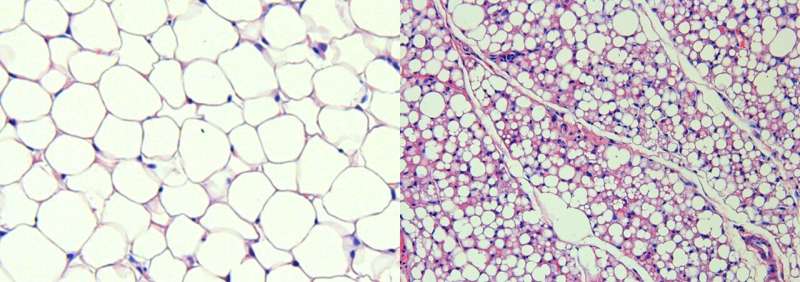This article has been reviewed according to Science X's editorial process and policies. Editors have highlighted the following attributes while ensuring the content's credibility:
fact-checked
peer-reviewed publication
trusted source
proofread
Study reveals brown fat's role in protecting blood sugar metabolism

While white fat stores calories, brown fat burns them. A new study, appearing in the journal Cell, reveals that brown fat improves metabolic health by providing nutrients important to other organs, rather than warming up body temperature.
Long seen as a villain in metabolic diseases such as diabetes, fat can play the hero too. A study by molecular biologist Shingo Kajimura and his colleagues delineates a new way that tissue known as brown fat protects health.
"The field has assumed that brown fat's metabolic benefits are simply due to its ability to generate heat by burning calories," says Kajimura, a Howard Hughes Medical Institute Investigator at Beth Israel Deaconess Medical Center. "But is this really all it does?"
This research says yes. His team has shown that brown fat breaks down amino acids to provide important nutrients that protect blood sugar metabolism—an insight that offers scientists another potential route to harnessing its benefits.
"Most people associate having too much fat with disease. And that's definitely true, but there's also good things that fat can do," says James Lo, an associate professor of medicine at Weill Cornell Medicine, who studies the beneficial effects of white and brown fat, and who was not involved in the study. "Shingo's work on amino acid metabolism showcases another point of view on this."
Explaining brown fat's benefits
The human body needs a certain amount of warmth to function well. To maintain an internal temperature in cold surroundings, we have two options: rapidly contract our muscles, a familiar process also known as shivering, and switching on our brown fat. Once thought only to be present in infants, who lack the musculature to shiver, brown fat turned up along the spines and necks of adults on scans intended to catch cancer metastasis.
Brown fat's distinctive color comes from the many tiny cellular organs, called mitochondria, it harbors. Mitochondria harvest energy from sugar and fat, but when triggered by temperature, those in brown fat switch to heat generation. Making heat consumes energy, in the form of calories, that could otherwise be stored by its counterpart, white fat.
According to conventional thought, this furnace-like function is responsible for brown fat's substantial metabolic benefits: improving the body's ability to manage sugar, fat, and cholesterol, and so reducing the likelihood of conditions such as type 2 diabetes and cardiovascular diseases.
But research, including work from Kajimura's lab, hinted it contributes in other ways too. A 2019 study offered a clue as to how, when it concluded that brown fat breaks down essential nutrients known as branched-chain amino acids (BCAAs). Although BCAAs provide the raw material for production of protein and the antioxidant glutathione, high levels of them in blood coincide with diabetes and obesity.
A link to the liver
In the new study, Kajimura's team investigated the tentative connection between brown fat and BCAAs with a time-honored approach: shutting it down.
In cells and in mice, they interfered with the ability of brown fat's mitochondria to break down BCAA. The resulting loss of glutathione, which protects against chemical wear and tear called oxidation, led to stress on the mice's livers. Because this organ contributes to blood sugar control—the loss of which is the hallmark of type 2 diabetes—the mice entered a diabetes-like state, which the researchers could reverse by giving them glutathione.
Study researcher Takeshi Yoneshiro, an associate professor at Tohoku University, extended these findings to humans, putting 33 men in a not-quite-shivering temperature of 19 degrees Celsius (66 degrees Fahrenheit) for two hours. Not only did the cold exposure increase brown fat activity as expected, it also increased glutathione production.
While these findings focus on the liver's role in sugar metabolism, brown fat may also influence processes elsewhere in the body, such as in muscle or the pancreas, Lo says. "There may be other things brown fat can do from a metabolic perspective."
Switching on brown fat without the cold?
While cold reliably activates brown fat, Kajimura and other researchers want to find another way for people to reap the metabolic benefits, without temperature-related drawbacks.
"First, it's not comfortable, I hate being cold," Kajimura says. "The second problem is that it can be bad for your heart, because it makes blood pressure go up."
While not a danger for someone in good health, extended exposure to cold can be risky for someone with cardiovascular disease. And people with metabolic diseases, such as type 2 diabetes and obesity, are more prone to these heart and blood vessel problems.
His lab is now looking for chemical-based ways to mimic the effect of cold, he says, noting that their discovery of brown fat's role in amino acid metabolism offers a potential new route for doing so.
More information: Anthony R.P. Verkerke et al, BCAA-nitrogen flux in brown fat controls metabolic health independent of thermogenesis, Cell (2024). DOI: 10.1016/j.cell.2024.03.030




















